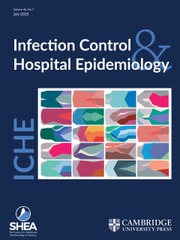To the Editor—We read with interest the letter by Landenberg et al.Reference Landenberg, Cole, Gild and Trinh 1 We would like to respond to the questions raised by the authors regarding our article.Reference Saito, Yasuhara, Murakoshi, Komatsu, Fukatsu and Uetera 2 The authors expressed concerns about the size or surface area of the instruments.Reference Landenberg, Cole, Gild and Trinh 1 They claimed that the assessment should have been confined to the area in direct contact with patients. This critique would be reasonable only if there were no transfer of contamination from the distal part to the proximal part. However, in terms of robotic instruments, it has been reported that surgical soil can travel up the shaft by gravity because the shaft is quite open.Reference Wallace, Wille, Roth and Hubert 3 We believe that the inside surface of the shaft should also be included in the measurement; therefore, we assessed the total amount of contamination of whole instruments.
The possibility of a false-positive effect was raised by the authors. They expressed concerns that higher protein values might be obtained due to substances from the distal working part and shaft, even after cleaning the instruments.Reference Landenberg, Cole, Gild and Trinh 1 This effect is thought to be caused by soil that originates from the manufacturing process.Reference Wallace, Wille, Roth and Hubert 3 – Reference Wehrl, Albers and Bühler 5 The effect can be minimized by reprocessing 3 times.Reference Wallace, Wille, Roth and Hubert 3 – Reference Wehrl, Albers and Bühler 5 In our study, however, the instruments had already been cleaned 10 times following the manufacturer’s instructions, which exceeded the cleaning process in previous studies.Reference Saito, Yasuhara, Murakoshi, Komatsu, Fukatsu and Uetera 2 Thus, it is not likely that our results were influenced by false-positive effects.
The authors claimed that the total protein from all the instruments used in a single operation should be compared rather than per-instrument protein.Reference Landenberg, Cole, Gild and Trinh 1 However, methods based on per-instrument measurement have been established to evaluate the cleanliness or cleaning efficacy of surgical instruments.Reference Wallace, Wille, Roth and Hubert 3 – Reference Carter, Krüger and Schmidt 6 The authors did not cite any relevant articles justifying their proposal; there is no basis for their claim.
We agree with the authors that protein itself does not have the ability to cause wound infections.Reference Landenberg, Cole, Gild and Trinh 1 Risk of infection associated with surgical instruments should be linked to the bacterial number and strain at the point of use. However, these do not necessarily persist for a long time, and they fluctuate over time. We believe that the results of the protein assay represent the maximum potential for infection. Many studies and guidelines adopt protein assay to assess contamination of surgical instruments.Reference Wallace, Wille, Roth and Hubert 3 – Reference Carter, Krüger and Schmidt 6 The authors’ comments appear to be broad. Again, they ignore the established approach to assessing contamination.
Decreased incidence of surgical site infection by robotic surgery has been reported, as stated in the articles cited by the authors of the letter.Reference Landenberg, Cole, Gild and Trinh 1 , Reference Tollefson, Frank and Gettman 7 However, the incidence of infection could be affected by publication bias.Reference Southworth 8 It is not possible to determine the actual incidence of infection related to accidental events because they tend not to be reported. Also, cases would not be identified when symptoms are not recognized as being associated with infection.Reference Southworth 8 In fact, there are reports of serious postoperative infections after 3 separate robotic surgical procedures, although the causes were unknown. 9 Similar cases may have occurred in other patients who had a longer hospital stays without infection being diagnosed. Presently, we do not have an appropriate modality to determine the actual incidence of occult infection. We do not agree with the authors’ claim based only on the reported incidence of infection.Reference Tollefson, Frank and Gettman 7
The aim of our article was to provide accurate information to avoid pitfalls such as cleaning failure. We are simply concerned that cases such as those mentioned above might occur sporadically, like outbreaks associated with endoscopic retrograde cholangiopancreatography procedures.Reference Wendorf, Kay and Baliga 10 Technology should not be developed ignoring safety. We believe that true innovations bring novel technology by applying principles of patient safety.
ACKNOWLEDGMENTS
Financial support. This study was supported by a Japan Society for the Promotion of Science Grant-in-Aid for Scientific Research (grant no. JP 15K19259).
Potential conflicts of interest. All authors report no conflict of interest related to this article.

